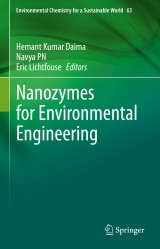Details

Nanozymes for Environmental Engineering
Environmental Chemistry for a Sustainable World, Band 63
|
96,29 € |
|
| Verlag: | Springer |
| Format: | |
| Veröffentl.: | 04.06.2021 |
| ISBN/EAN: | 9783030682309 |
| Sprache: | englisch |
Dieses eBook enthält ein Wasserzeichen.
Beschreibungen
<p>This book reviews the latest developments and applications of nanozymes in environmental science. Protection of the environment is essential because pollution has become a global problem with many adverse effects on life and ecosystems. For that, remediation strategies and techniques have been designed, yet they are limited. Here, the recent development of nanotechnology opens a new vista for environmental remediation. In particular, nanomaterials displaying enzyme-like activities, named ‘nanozymes’, appear very promising for environmental monitoring, contaminant detection, microbial management, and degradation of organic pollutants. Nanomaterials including metallic, metal oxides and carbon-based nanoparticles with nanozymes activities have been synthesized. These nanozymes have similar activities as natural peroxidase, oxidase, superoxide dismutase and catalase enzymes. Nanozymes have several advantages, yet they suffer from several limitations such as low catalytic efficiency, less substrate selectivity, biocompatibility, and lack of engineering of the active sites.</p>
Preface.- Chapter 1 Amino acids functionalized inorganic metal nanoparticles: Synthetic nanozymes for target specific binding, sensing and catalytic applications.- Chapter 2 Thermal decomposition routes for magnetic nanoparticles: development of next-generation artificial enzymes, their phase transfer and biological applications.- Chapter 3 Nanozymes: Emerging Nanomaterials to Detect Toxic Ions.- Chapter 4 Applications of nanozymes in wastewater treatment.- Chapter 5 Aptamer mediated sensing of environmental pollutants utilizing peroxidase mimic activity of nanozymes.- Chapter 6 Nanozyme-based sensors for pesticide detection.- Chapter 7 Metal-based nanozyme: Strategies to modulate the catalytic activity to realize environment application.- Chapter 8 Nanozymes in Environmental Protection.
<p><b>Dr. Hemant Kumar Daima</b>, is nano-biotechnology expert at Amity University Rajasthan, India and visiting scientist at RMIT University, Australia. His research findings have revealed guiding principles involved in rational nanoparticle design strategies for biomedical applications. He is editorial member of leading scientific publishers, member of numerous scientific/professional bodies, and recipient of international fellowships/awards.</p>
<p><b>Navya PN</b> is assistant professor at the Bannari Amman Institute of Technology, India. She is cofounder of Nano-Bio Interfacial Research Laboratory (NBIRL). Her research works are at the interface between nanotechnology and biology. She is recipient of several international fellowships.</p>
<p><b>Dr. Eric Lichtfouse</b> is professor of environmental chemistry and scientific communication at Aix-Marseille University, France and Xi’an Jiaoting University, China. He has invented carbon-13 dating based on the discovery of temporal pools of organic molecules in soils. He is Chief Editor and co-founder of the journal Environmental Chemistry Letters, and the book series Sustainable Agriculture Reviews and Environmental Chemistry for a Sustainable World. He has published the book Scientific Writing for Impact Factor Journals.</p>
<p><b>Navya PN</b> is assistant professor at the Bannari Amman Institute of Technology, India. She is cofounder of Nano-Bio Interfacial Research Laboratory (NBIRL). Her research works are at the interface between nanotechnology and biology. She is recipient of several international fellowships.</p>
<p><b>Dr. Eric Lichtfouse</b> is professor of environmental chemistry and scientific communication at Aix-Marseille University, France and Xi’an Jiaoting University, China. He has invented carbon-13 dating based on the discovery of temporal pools of organic molecules in soils. He is Chief Editor and co-founder of the journal Environmental Chemistry Letters, and the book series Sustainable Agriculture Reviews and Environmental Chemistry for a Sustainable World. He has published the book Scientific Writing for Impact Factor Journals.</p>
<p>Protection of the environment is essential because pollution has become a global problem with many adverse effects on life and ecosystems. For that, remediation strategies and techniques have been designed, yet they are limited. Here, the recent development of nanotechnology opens a new vista for environmental remediation. In particular, nanomaterials displaying enzyme-like activities, named ‘nanozymes’, appear very promising for environmental monitoring, contaminant detection, microbial management, and degradation of organic pollutants. Nanomaterials including metallic, metal oxides and carbon-based nanoparticles with nanozymes activities have been synthesized. These nanozymes have similar activities as natural peroxidase, oxidase, superoxide dismutase and catalase enzymes. Nanozymes have several advantages, yet they suffer from several limitations such as low catalytic efficiency, less substrate selectivity, biocompatibility, and lack of engineering of the active sites. This bookreviews the latest developments and applications of nanozymes in environmental science.</p>
This book is a platform to convey fundamental concepts on nanozymes It describes the reaction mechanism, current trends, limitations, and future directions for environmental treatment through nanozymes The book has unique contributions on the state-of-the-art research from global leaders
Diese Produkte könnten Sie auch interessieren:

Water Quality Hazards and Dispersion of Pollutants

von: Wlodzimierz Czernuszenko, Pawel Rowinski

149,79 €















